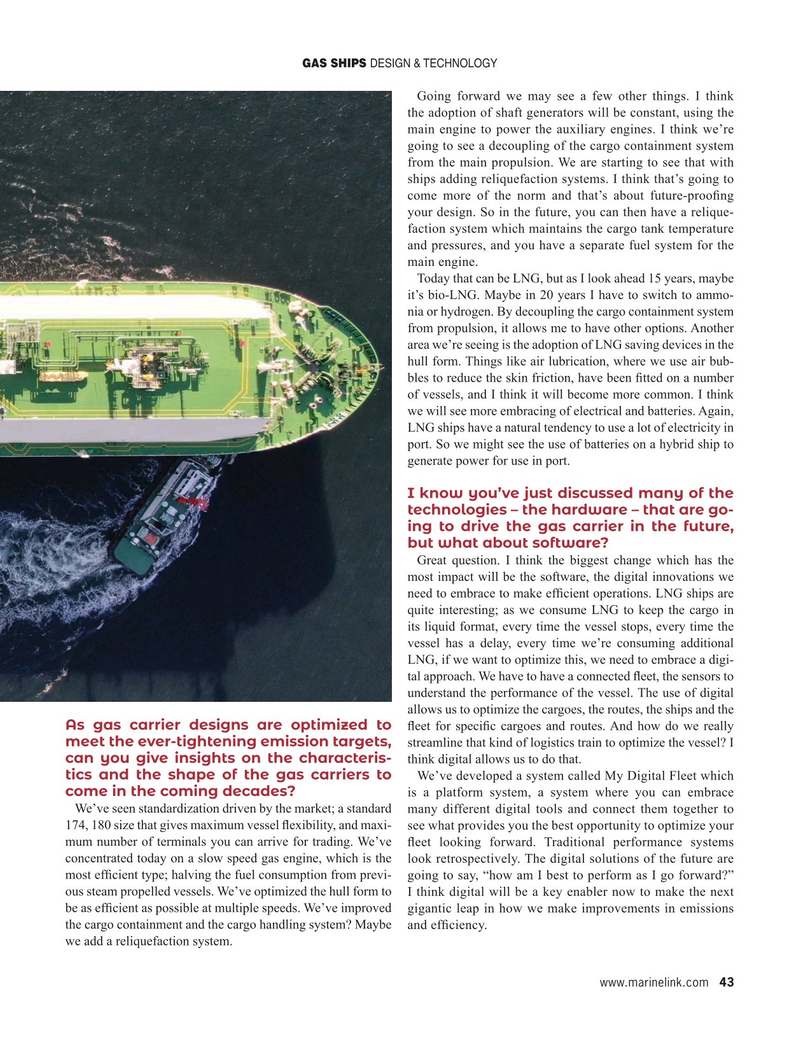
Page 43: of Maritime Reporter Magazine (June 2021)
USCG Fleet Modernization Annual
Read this page in Pdf, Flash or Html5 edition of June 2021 Maritime Reporter Magazine
GAS SHIPS DESIGN & TECHNOLOGY
Going forward we may see a few other things. I think the adoption of shaft generators will be constant, using the main engine to power the auxiliary engines. I think we’re going to see a decoupling of the cargo containment system from the main propulsion. We are starting to see that with ships adding reliquefaction systems. I think that’s going to come more of the norm and that’s about future-proo? ng your design. So in the future, you can then have a relique- faction system which maintains the cargo tank temperature and pressures, and you have a separate fuel system for the main engine.
Today that can be LNG, but as I look ahead 15 years, maybe it’s bio-LNG. Maybe in 20 years I have to switch to ammo- nia or hydrogen. By decoupling the cargo containment system from propulsion, it allows me to have other options. Another area we’re seeing is the adoption of LNG saving devices in the hull form. Things like air lubrication, where we use air bub- bles to reduce the skin friction, have been ? tted on a number of vessels, and I think it will become more common. I think we will see more embracing of electrical and batteries. Again,
LNG ships have a natural tendency to use a lot of electricity in port. So we might see the use of batteries on a hybrid ship to generate power for use in port.
I know you’ve just discussed many of the technologies – the hardware – that are go- ing to drive the gas carrier in the future, but what about software?
Great question. I think the biggest change which has the most impact will be the software, the digital innovations we need to embrace to make ef? cient operations. LNG ships are quite interesting; as we consume LNG to keep the cargo in its liquid format, every time the vessel stops, every time the vessel has a delay, every time we’re consuming additional
LNG, if we want to optimize this, we need to embrace a digi- tal approach. We have to have a connected ? eet, the sensors to understand the performance of the vessel. The use of digital allows us to optimize the cargoes, the routes, the ships and the
As gas carrier designs are optimized to ? eet for speci? c cargoes and routes. And how do we really meet the ever-tightening emission targets, streamline that kind of logistics train to optimize the vessel? I can you give insights on the characteris- think digital allows us to do that. tics and the shape of the gas carriers to
We’ve developed a system called My Digital Fleet which come in the coming decades?
is a platform system, a system where you can embrace
We’ve seen standardization driven by the market; a standard many different digital tools and connect them together to 174, 180 size that gives maximum vessel ? exibility, and maxi- see what provides you the best opportunity to optimize your mum number of terminals you can arrive for trading. We’ve ? eet looking forward. Traditional performance systems concentrated today on a slow speed gas engine, which is the look retrospectively. The digital solutions of the future are most ef? cient type; halving the fuel consumption from previ- going to say, “how am I best to perform as I go forward?” ous steam propelled vessels. We’ve optimized the hull form to I think digital will be a key enabler now to make the next be as ef? cient as possible at multiple speeds. We’ve improved gigantic leap in how we make improvements in emissions the cargo containment and the cargo handling system? Maybe and ef? ciency.
we add a reliquefaction system.
www.marinelink.com 43
MR #6 (34-49).indd 43 6/3/2021 3:45:17 PM

 42
42

 44
44
